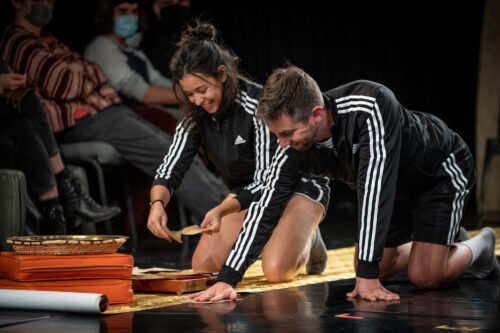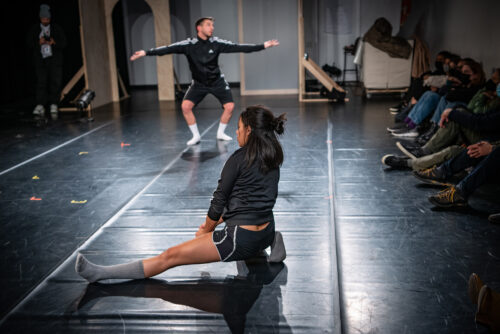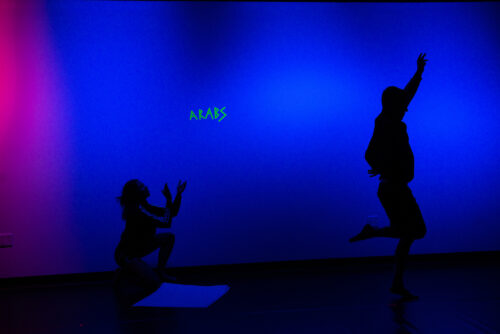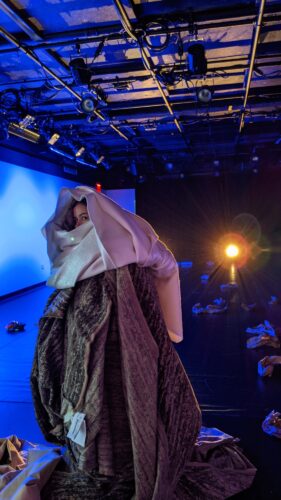Nora Alami and Jadd Tank Invite Audiences into 3rd Body

Photo by Toby Tenenbaum
If you’re a Millennial of a certain age, the wellspring of imagination, creativity, and big-kid emotions probably has as one of its many sources the cultural phenomenon that was the Disney Renaissance. For a decade, the famed animation studio produced animated musicals of fairy tales, myths, and literary works that enchanted a generation of kids who grew up in the 90s. (For this writer, the first feature of the Renaissance, The Little Mermaid (1989), marked his first trip to the movie theater.)
This pantheon of animated features rendered the world in big, bold colors that unfortunately painted over the complex histories and cultures of the stories they portrayed. With the premiere of Aladdin in 1992, a decade before the events of 9/11, American children were held spellbound by an Arab world of mystery, magic, and mysticism. Aladdin, Jasmine, and the denizens of Agrabah may have been cut from the same cloth as the characters of Disney’s other princess stories, but they were also decidedly not like us. Aladdin, in a nutshell, is an example of the othering of the Arab world, as described in Edward Said’s Orientalism.

Photo by Toby Tenenbaum
But what exactly makes Aladdin and Jasmine different from Belle and the Beast, Ariel and Prince Eric, and Cinderella and her Prince Charming? They are Arab, but what makes an Arab? And what if an Arab isn’t Arab enough? Who determines that? Choreographers Nora Alami and Jadd Tank have asked themselves these questions their entire lives, and are exploring this theme of identity in their collaborative series, 3rd Body, which is currently in residence at the Houston Metropolitan Dance Center. Their two-week residency, their fourth under this ongoing project, will culminate in a showing of their research on Saturday, April 23rd at 8pm.
“3rd Body is set in the discomfort of discussing identity,” says Alami. “The feeling we’re exploring is the longing to belong.” Alami, a Moroccan-American, met Tank, a Lebanese-American, in New York in 2018 on “Bourgeois-Z”, a dance work that toured in Italy. Both realized that their repertoire was meeting with the same response; for some, their dances were too Arab, and for others, it wasn’t Arab enough. In 2020, when the world was shut down and everyone was confined to their own private spaces, Alami and Tank began to deepen their conversations and started conceptualizing a choreographic work that would explore their individual and shares histories of being tertiary bodies within American culture.

Photo by Toby Tenenbaum
The creators describe 3rd Body as a play told through dance, about Arabs who were told about their Arab-ism by non-Arabs. “Part of the structure of 3rd Body is that it’s told through simulations that you can peer into as an audience member,” says Alami. “The audience is then pulled out of them and dropped into the next world. The simulations are expressed through abstractionism, surrealism, and futurism.”
The Houston residency marks the fourth in the series, with the previous iterations created in New York. Each residency has mined different simulations in preparation for a world premiere in the fall of 2023. For Houston, Alami and Tank will be fleshing out a section they call “A Magic Carpet Ride” that sees a reimagined Aladdin and Jasmine hired by the CIA to conduct drone surveillance on Agrabah. Their showing will be followed by a question and answer discussion, which will shape the course of future residencies.

Photo by Jadd Tank
“As creative producers, we’ve both done a lot on the back end of the arts,” says Tank. “We are big on this idea of not looking at our art as a one-time experience. We believe in the byproducts as well.” Some of these byproducts include translating the piece into non-dance outputs, such as university lectures and a coffee table book, but also the discourse that is generated by their research and audience feedback. The pair seem to find comfort in the ideation phase of the creation process, where others might find relief in rushing through.
‘Moving at the pace of the work’ is also another value that comes into play,” says Alami. “We think of performance as practice, performance as research. Yes, performance can be the end. And sometimes a time container creates powerful work. But sometimes you just need to stay with the work.”
In Houston, the chance for a choreographer to stay with their work is few and far between. The 3rd Body residency and performance is being made possible by the efforts of the Houston Metropolitan Dance Center’s jhon r. stronks, who is in the process of building an artist-in-residence program at the organization’s space at 4916 Main Street.
“It’s integral. It’s vital. It’s a money-back guarantee,” says Tank, quoting his mentor Michelle Ellsworth, when asked about the importance of having space that doesn’t come attached to a rental fee. “When you can be provided the tools and the resources and the time and space to be able to just sit there for two hours, and to do it in a dance studio, it’s a whole different experience.”
An experience that in turn can help dance-makers create meaningful and deeply felt experiences for their audiences.
3rd Body opens on Saturday, April 23 @ 8pm at the Houston Metropolitan Dance, 4916 Main Street, Suite 100. For tickets and more information, visit https://www.metdance.org/3rd-body-residency.



Recent Comments